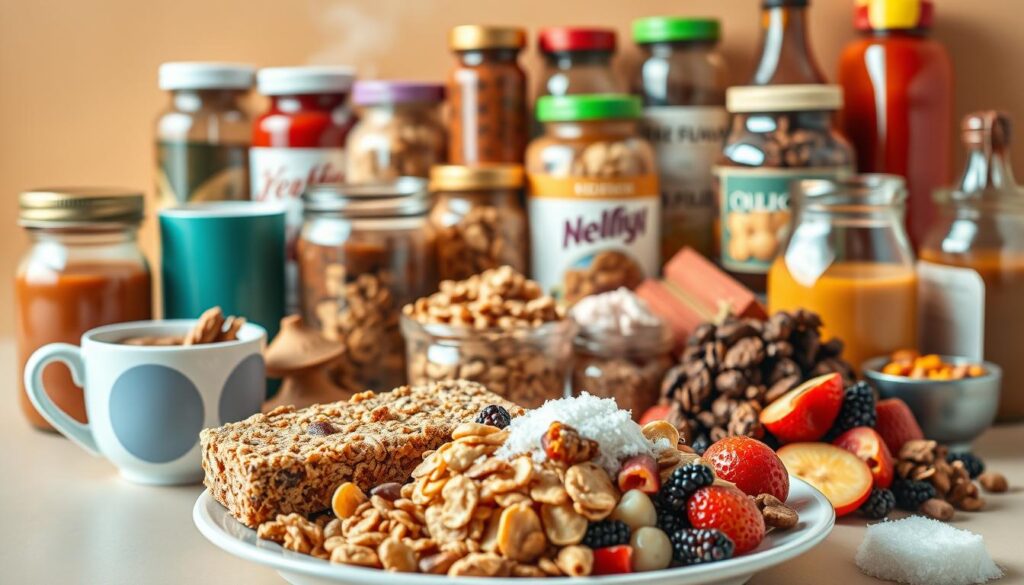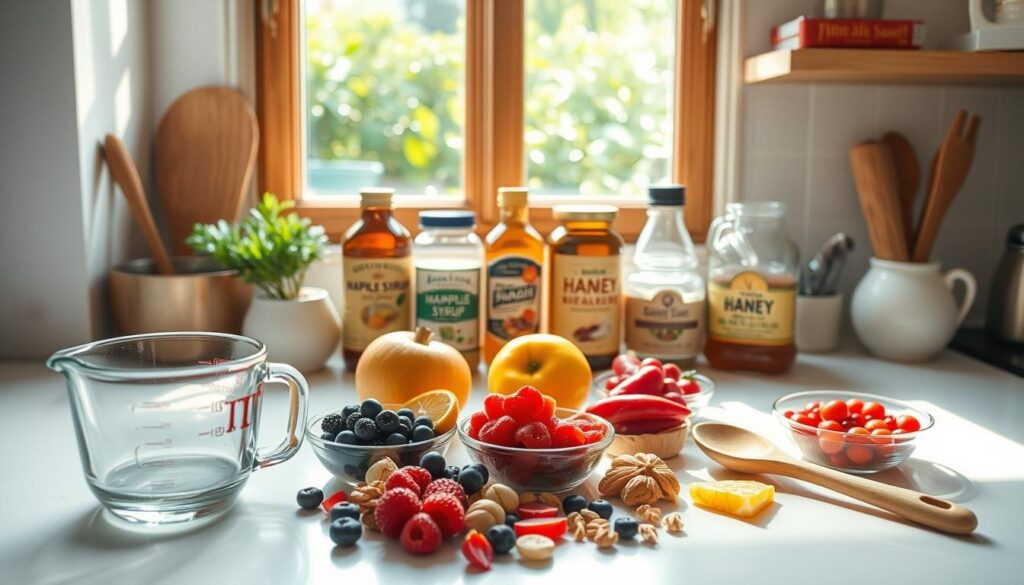Physical Address
304 North Cardinal St.
Dorchester Center, MA 02124
Physical Address
304 North Cardinal St.
Dorchester Center, MA 02124

Did you know the average American consumes 22 teaspoons of added sugar every day? That’s nearly three times the recommended amount for women.
Most people associate sugar with obvious treats like candy or desserts. But sweeteners sneak into many everyday items you wouldn’t suspect.
Savory sauces, breads, and even “healthy” snacks often contain significant amounts. This hidden consumption poses real health risks, especially for those monitoring blood sugar levels.
Understanding where these sugars lurk is the first step toward better dietary choices. This knowledge empowers you to take control of your nutrition and well-being.
Understanding sugar types can transform how you approach your daily nutrition choices. Not all sweeteners affect your body the same way, making this knowledge essential for informed eating.
Naturally occurring sugars exist in whole foods like fruits, vegetables, and dairy products. These sweeteners come packaged with beneficial nutrients that support overall health.
Fresh fruits contain fructose along with fiber, vitamins, and minerals. This combination slows sugar absorption into your bloodstream. The fiber content helps regulate blood sugar levels naturally.
Dairy products like milk contain lactose, another natural sugar. These foods provide essential calcium and protein alongside their sweet content. Your body processes these sugars differently than refined versions.
“Natural sugars in whole foods come with nutritional benefits that added sugars lack.”
Vegetables like carrots and beets also contain natural sweetness. These options deliver antioxidants and phytochemicals that support wellness. Choosing whole foods maximizes nutritional value while satisfying sweet cravings.
Added sugars are incorporated during food processing for various reasons. Manufacturers use them to enhance flavor, improve texture, and extend shelf life. These sweeteners appear in many unexpected places.
Even savory items like pasta sauce often contain significant amounts. The sugar balances acidity and creates a more appealing taste profile. This practice makes reading labels essential for conscious consumers.
Common sources include soda, candy, and processed snacks. But many “healthy” options like yogurt and granola bars also contain added sweeteners. These contribute empty calories without nutritional benefits.
The American Heart Association recommends specific limits for added sugar intake. Women should aim for no more than 25 grams daily, while men can have up to 36 grams. Exceeding these amounts regularly increases health risks.
Your body processes added sugars differently than natural versions. Without accompanying fiber and nutrients, these sweeteners cause rapid blood sugar spikes. This can lead to energy crashes and increased hunger signals.
Learning to identify added sugars empowers better dietary decisions. This knowledge helps reduce overall consumption while maintaining enjoyable eating experiences. Making informed choices supports long-term wellness goals.
Mastering label reading transforms grocery shopping into an informed health decision. This skill reveals what manufacturers might not highlight on packaging fronts.
Learning to interpret nutrition facts panels and ingredient lists empowers smarter choices. You’ll quickly identify products with excessive sweeteners.
Modern nutrition labels clearly separate total sugars from added varieties. This distinction helps consumers understand a product’s true sugar content.
Total sugars represent all sweeteners present in a food item. This includes both naturally occurring and added types.
Subtract added sugars from total sugars to calculate natural sugar content. This simple math reveals a product’s actual nutritional profile.
For example, plain yogurt shows total sugars from lactose. Flavored versions display higher numbers due to added sweeteners.
Ingredients appear in descending order by weight on all packaging. The first three items typically make up most of the product.
When sugar appears early in this list, expect significant sweetener content. Manufacturers sometimes use multiple sugar types to distribute them lower.
This practice makes individual sweeteners appear less prominent. The combined amount often remains substantial despite this strategy.
Always scan the entire ingredient list for various sugar forms. Multiple sweeteners indicate intentional flavor enhancement.
Manufacturers use numerous names for sweeteners on ingredient lists. Recognizing these terms helps identify hidden sugar sources.
Common sugar aliases include:
Even seemingly healthy options like sports drinks or breakfast cereals often contain these hidden sweeteners. Always verify ingredient lists rather than trusting front-label claims.
“If you can’t pronounce it, it’s probably sugar in disguise.”
Quick scanning techniques save time while shopping. Check the added sugars line first, then review ingredient order.
This approach helps identify high-sugar products efficiently. You’ll make better choices without spending hours reading every label.
Many everyday items contain surprising amounts of sweeteners that quickly add up. These unexpected sources can sabotage even the most careful eating plans.
Learning where these sugars hide helps you make smarter choices. This knowledge protects your health while maintaining enjoyable meals.

Ketchup, barbecue sauce, and salad dressings often contain significant added sugar. These products use sweeteners to balance flavors and improve shelf life.
Teriyaki and hoisin sauces can have surprisingly high sugar content. Even pasta sauce frequently includes added sweeteners beyond natural fruit sugars.
Small servings quickly contribute to daily sugar intake. Checking labels reveals the true content of these common kitchen staples.
Flavored yogurt often contains more sugar than protein. Some varieties pack over 20 grams of sweeteners per serving.
Granola and protein bars frequently use honey, syrup, or other added sugars. Marketing claims about health benefits sometimes mask high sugar content.
Always compare protein grams to sugar grams when selecting these foods. Choose options with more protein than sugar for better nutrition.
Sports drinks, sweetened teas, and coffee beverages deliver massive sugar amounts. Many people consume these regularly without considering the impact.
Even fruit juices often contain added sugars beyond natural fructose. A single serving can approach the daily recommended limit.
Research links sugary drink consumption to increased health risks. These beverages represent one of the largest sources of empty calories.
Breakfast cereals, even whole grain varieties, often contain added sugars. Instant oatmeal packets frequently include substantial sweeteners.
Some breads contain sugar or high-fructose corn syrup for texture and flavor. This includes many commercially produced whole wheat options.
Portion sizes dramatically affect sugar intake from these morning foods. Reading ingredient lists helps identify better choices.
Canned fruits in syrup, sweetened nut butters, and flavored milk also contribute hidden sugars. These everyday items can significantly increase your daily consumption.
Always verify labels rather than trusting packaging claims. This simple habit helps manage overall sugar intake effectively.
Implementing effective strategies makes reducing sweetener consumption achievable without sacrificing enjoyment. Small, consistent changes create lasting habits that support better health outcomes.
Focus on gradual adjustments rather than complete elimination of favorite items. This approach prevents feelings of deprivation while steadily lowering daily sugar amounts.

Selecting better options begins with understanding product labels. Look for items with less than 5 grams of added sugar per serving.
Plain Greek yogurt with fresh berries beats flavored varieties. You control sweetness while getting more protein and fewer empty calories.
Whole fruits satisfy cravings better than juice or dried versions. Their fiber content slows sugar absorption into your bloodstream.
Unsweetened plant milks offer excellent alternatives to sweetened dairy options. Almond, oat, and coconut varieties provide variety without added sugars.
Simple substitutions dramatically reduce your daily sugar intake. These swaps maintain flavor while improving nutritional value.
Try sparkling water with citrus instead of soda or sports drinks. You get refreshment without excessive sweeteners.
Homemade oatmeal with cinnamon beats pre-sweetened packets. Add nuts and fresh fruit for natural sweetness and texture.
Dark chocolate above 70% satisfies cravings better than milk chocolate. It contains less sugar and more beneficial antioxidants.
Nut butters without added sugars provide healthy fats and protein. Check ingredient lists to avoid hidden sweeteners.
“The best sugar substitute is often no substitute at all – just whole, real food.”
Artificial sweeteners like sucralose and aspartame provide zero-calorie options. These sugar substitutes don’t raise blood sugar levels significantly.
Natural alternatives like stevia come from plant sources. They offer sweetness without calories or carbohydrates.
Some people experience digestive issues with certain sugar substitutes. Bloating or diarrhea may occur with excessive consumption.
Moderation remains key when using any sweetener alternative. Whole foods like fruits and vegetables provide better nutritional value.
Read labels carefully on products containing sugar substitutes. Some “sugar-free” items contain other questionable ingredients.
Portion control helps manage sugar intake from favorite foods. Measure servings instead of eating directly from packages.
Create your own trail mix with unsweetened cereal, nuts, and limited dried fruit. This controls sugar content better than store-bought versions.
Homemade sauces and dressings avoid hidden sugars found in commercial products. Use herbs, spices, and citrus for flavor enhancement.
Gradual reduction allows your taste buds to adjust to less sweetness. Start by cutting added sugar by half in recipes.
Focus on whole, unprocessed foods as your primary nutrition strategy. These naturally contain lower amounts of added sugars.
Regular overconsumption of sweeteners creates serious health consequences that extend far beyond empty calories. Understanding these risks empowers smarter dietary decisions for long-term wellness.
Excess sugar intake directly contributes to weight gain through multiple mechanisms. Sweetened foods and drinks provide concentrated calories without nutritional value.
Your body processes these empty calories differently than nutrient-dense options. High sugar consumption often leads to increased overall calorie intake.
Research confirms strong connections between sweetener consumption and cardiovascular issues. Studies show elevated heart disease risk with regular high sugar intake.
Stroke risk also increases significantly with excessive consumption. These findings highlight the importance of moderation for heart health.
Children face particular vulnerability to sugar’s negative effects. Nearly one-third of American children now meet overweight or obesity criteria.
Reducing sweetener intake represents a crucial strategy for protecting youth health. Early habits establish patterns that continue into adulthood.
The American Academy of Pediatrics recommends zero added sugar for children under two years. This guidance reflects concerns about developing taste preferences and health outcomes.
Even small amounts quickly accumulate in children’s diets. A single serving of juice or sweetened milk can approach daily limits.
Consistent high sugar consumption strains your body’s insulin response system. This stress can lead to insulin resistance over time.
Insulin resistance represents a primary risk factor for developing type 2 diabetes. Managing sweetener intake helps maintain healthy blood sugar levels.
Artificial sweeteners may create unexpected metabolic responses. Some research suggests they might increase appetite and insulin response.
Additional health concerns connected to excessive sugar consumption include:
“Reducing added sugar intake represents one of the most effective lifestyle changes for improving multiple health markers.”
Statistics reveal the widespread impact of sugar-related health issues. Cardiovascular disease remains the leading cause of American deaths.
Diabetes affects over 34 million people in the United States. These conditions often develop gradually through dietary patterns.
Making conscious reductions in sweetener consumption delivers measurable benefits. Improved blood pressure, cholesterol levels, and weight management often follow.
Even modest decreases in sugar intake can significantly impact health outcomes. Small changes create substantial long-term benefits for overall wellness.
Reducing excess sugar consumption doesn’t require eliminating favorite foods from your diet. The key is awareness and moderation.
Check nutrition labels to understand the amount of sugars in products. Many common foods contain hidden sugars that add up quickly.
Enjoy treats in sensible portions rather than cutting them out completely. This approach reduces health risk while maintaining enjoyment.
Small changes create big benefits over time. Continue learning about nutrition to make informed choices that support your health goals.